| [naar
Mozart-biografie 1]
[terug naar inhoud
Mozart-biografie 2]
[naar
literatuurlijst]
inhoud:
|
BIOGRAPHY
Talking about Wolfgang Amadeus Mozart and his family
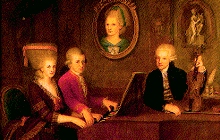
Wolfgang Amadeus Mozart
was one of the greatest composers the world has ever seen. A prodigy already
in his early childhood, he was a successful musician during his whole lifetime
- even when giving up his safe employment and working as a free-lance artist.
3720 of the 13097 days of his short life Mozart spent travelling, still
most of his compositions originated in Salzburg, the town where he was
born and lived until 1781, and in Vienna, where he spent the last 10 years
of his life.
Wolfgang Amadeus Mozart was born on January 27, 1756 at the Hagenauersches
Haus in Salzburg (today's Getreidegasse 9). Here he learned to play
the violin and the harpsycord and made his first compositions.
He died on December 1791 in his flat at Vienna's Rauhensteingasse, where
he had composed the famous Ave Verum (K618) and the Requiem
(K626).
Father:

Leopold Mozart, born 1719 in Augsburg ( Germany) and died 1778 in Salzburg.
In 1737 he moves to Salzburg to study law and philosophy. Abandons his
studies and marries Anna Maria Pertl in 1747. Violin teacher, court composer,
vice conductor at the Prince-Archbishop's court in Salzburg. Writes a world-famous
violin school. Is well aware of his son's exceptional talent and becomes
his teacher and impresario.
Mother:
Anna Maria Pertl, born on December 25, 1720 in St. Gilgen on Lake Wolfgangsee,
dies in Paris 1778 on a concert tour. With Leopold Mozart she has seven
children, five of which die shortly after birth.
Sister:
Maria Anna ("Nannerl") Mozart, born on July 30, 1751 in Salzburg, where
she died in 1829. Musically talented, accompanies Wolfgang in his concerts.
Gives piano lessons until she is very old. Marriage with Johann Baptist
Reichsfreiherr von Berchtold zu Sonnenburg in 1784.
The first split with Salzburg's Archbishop
Move
In the fall of 1773 the Mozart family moves from Hagenauerhaus at
Salzburg's Getreidegasse to a larger flat at the so-called Tanzmeisterhaus
at Hannibalplatz (today's Marktplatz). The flat is spacious enough for
concerts in the family's large circle of friends.
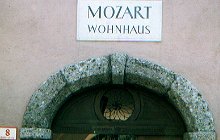
An opera for Munich
In the fall of 1774 Mozart composes the opera buffa "La finta giardiniera"
(K196) commissioned by the Bavarian Elector Maximilian III on the occasion
of Munich's carnival. The work is premiered in Munich on January 13, 1775
under Mozart's baton; however, there are only two more performances.
More commissions
Mozart becomes more and more famous also in Salzburg. Musical works are
commissioned by Josef Nepomuk Graf Lodron ("Lodron'sche Nachtmusiken",
K247 and 287) and Sigmund Haffner ("Haffner-Serenade" K250).
Dismissal from court service (August 1777)
Leopold Mozart is planning another concert tour with Wolfgang to Western
Europe.
They are, however, not granted leave from court services. Wolfgang hands
in a written application with Elector Colloredo requesting his and his
father's dismissal. Wolfgang is dismissed, his father's employment can
be maintained only with great difficulty.
The journey to Paris
(September 1777-September 1778)
Wolfgang Amadeus Mozart travels in company of his mother.
Munich (late September 1777)
First stop. He tries in vain to find an appropriate employment.
Augsburg (October 1777)
Home town of his father. Mozart has a love affair with his cousin Maria
Anna Thekla Mozart, who he calles "Bäsle".
Mannheim (November 1777-March 1778)
A small town with a great music tradition. The court orchestra of Elector
Karl Theodor has the reputation of being the best orchestra in the German-speaking
countries. Mozart works with the orchestra and its concertmaster Christian
Cannabich. He gets acquainted with the Weber family and falls head over
heels in love with their 17-year old daughter Aloisia. Later he is to get
married
to her sister Constanze.
Paris (March-September 1778)
Mozart becomes famous quickly. He is part of the city's music life
but fails to make a living here. His mother falls ill and dies on July
3. Leopold Mozart convinces Prince-Archbishop Colloredo to employ his son
once again. The latter leaves Paris end of September returning to Salzburg.
His journey goes via Strasbourg, Mannheim and Munich.
Concert tours and first compositions of the child prodigy
(1762 - 1773)
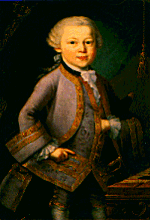
Munich (January 1762)
Leopold Mozart and his two children leave for a three-week journey
to Munich. Concert at the Court of the Elector of Bavaria.
Vienna (September 1762 - January 1763)
Journey to Vienna by mail ship from Passau via Linz. Arrival in Vienna
on October 6, 1762. The family most presumably stays at the inn "Zum weissen
Ochsen" (Fleischmarkt 28), later at a house on Tiefer Graben which no longer
exists. Daily performances at palaces and houses of noble families; debut
at Palais Collalto (today's address: Am Hof 13)
Performance for Empress Maria Theresa at Schönbrunn Palace.
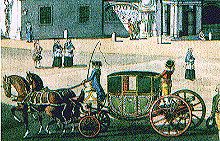
Western Europe (June 1763 - November 1766)
Mozart's first journey to Western Europe becomes an overwhelming success.
Concerts in various German cities. Visiting relations in Augsburg. Prolonged
stay in Paris. First sonatas for violin and piano (K6-15).
Meeting with Johann Christian Bach in London. Various piano compositions
and Mozart's first symphony (K6). On the journey back Mozart falls heavily
ill with typhoid fever.
Salzburg (December 1766 - September 1767)
Short stay in Salzburg. Performance of the spiritual singspiel "Die
Schuldigkeit des ersten Gebots" (K35). Part one has been composed
by Mozart, part two by Michael Haydn and part three by Cajetan Adlgasser,
court organist in Salzburg.
Vienna (September 1767 - January 1769)
Journey from Salzburg to Vienna by horse carriage. Itinerary: Vöcklabruck,
Lambach, Linz, Strengberg, Melk (Mozart plays the organ at the Abbey),
St. Pölten, Purkersdorf, Vienna. Lodging at Weihburggasse 3. The family
flees from a smallpox epidemic to Bohemia but both Wolfgang and his sister
fall ill. When returning to Vienna the family stays at the house "ZumRoten
Säbel" (Wipplingerstrasse 19, no longer existing). Audience with
Empress Maria Theresa. Joseph II (Maria Theresa's son and co-regent) commissions
Mozart with an opera. Various concerts, performance of the singspiel "Bastien
and Bastienne" (K50). Performance of the "Waisenhaus Mass" (K139)
conducted by Mozart, at the opening of the "Waisenhaus-Kirche" (Rennweg
91).
Salzburg (January - December 1769)
Performance of "La Finta Semplice" (K 51), the opera commissioned
by Joseph II, at Salzburg "Residenz" palace. At the age of 13 years Mozart
is appointed honorary conductor of the Salzburg Court Orchestra (November
14, 1769)
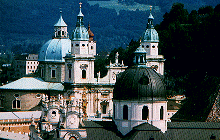
Italy - first and second journeys (December 1769 - December 1771)
Father Leopold Mozart travels with Wolfgang to Italy, hoping to procure
his son's employment at a royal court. The journey is partly financed by
Salzburg's Prince Archbishop. The journey leads through entire northern
Italy. Many casual compositions for famous singers.
First performance of the opera "Mitride, Ré di Ponto"
in Milan.
In Bologna, Mozart takes counterpoint lessons with the great theorist
Padre Giovanni Battista Martini and becomes a member of the "Accademia
Filarmonica". He is awarded the noble title "Ritter vom goldenen Sporn"
("Knight of the Golden Spur") by Pope Clemens XIV. Although he becomes
honorary conductor in Verona his father's efforts for employment in Italy
fail. After staying in Salzburg between April and August 1771 the two return
to Italy again.
Salzburg (December 1771 - October 1772)
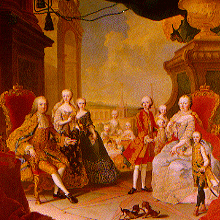
The family's most important patron Prince-Archbishop Siegismund Count
of Schrattenbach, dies on December 16, 1771 in Salzburg. He is succeeded
by Hieronymus Count Colloredo, a passionate advocate of the Enlightenment.
For his inthronisation Mozart composes the allegorical music drama "Il
sogno di Scipione". (April - May 1772). Colloredo promotes him to the
office of salaried conductor.
Italy - third journey (October 1772 - March 1773)
Father and son Mozart travel again to Italy, mainly because of the
premiere of the opera "Lucio Silla" (K135) in Milan. During the
carnival of 1772/73 the work is performed 26 times.
Vienna (July 1773 - September 1773)
Accommodation at house no. 322 on Tiefer Graben in Vienna's city center
(no longer existing). Mozart's hopes for employment at the Emperor's Court
are not fulfilled.
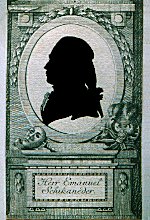
The final split with the Salzburg Prince-Archbishop
Court organist in Salzburg (1779)
Mozart arrives in Salzburg in January 1779. On January 17 he is employed
as court organist earning a handsome salary. This position demands his
performance in the festive masses at Salzburg Cathedral. He is,
however, not obliged to compose for the liturgy regularly. He composes
his church music works mostly for special occasions.
Friendship with Schikaneder (September 1780)
Emanuel Schikaneder and his company of actors come to Salzburg and get
acquainted with the Mozart family.
A new festive opera for Munich (Fall/winter 1780)
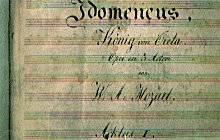
Mozart is commissioned with an opera on the occasion of the forthcoming
carnival. On November 5 he travels to Munich. Premiere of the opera "Idomeneo,
Rè di Creta" (K366) on January 29.
The final split with the Salzburg Prince-Archbishop
On November 29, 1780 Empress Maria Theresa dies. Prince-Archbishop Colloredo
moves to Vienna in January accompanied by his princely household in order
to visit his ill father and to participate in the political scenario preceding
the succession to the throne. Mozart, who has been on vacation in Munich
much longer than previously planned, is ordered back to Vienna urgently
by Colloredo. He arrives in Vienna on March 16 and lives at the "Haus
des Deutschen Ordens" (today Singerstrasse 7). Here he composes
the violin sonata in G major (K379), among others. As musician of
the Salzburg Prince-Archbishop he performs before Vienna's high-society
circles.
Because of the unique impressions he has of the city ("for my profession
the best place in the world") he does not want to return to Salzburg with
the Prince-Archbishop. On May 9 he breaks finally with Colloredo. The split
is confirmed on June 8, 1781 with the famous kick of a high Salzburg court
official.
Mozart stays in Vienna as a free-lance musician. In the beginning he
lives as a guest of the Weber family (who have moved to Vienna) in the
house "Zum Auge Gottes" on Petersplatz (today Petersplatz 11, while
the house itself does not exist any longer).
The first years in Vienna - an artistic peak
(1781-1787)
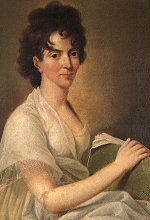
Wolfgang Amadeus Mozart soon gets accepted by the Viennese society and
starts his "big" career here. He performs innumerable private and public
concerts (so-called "Academies") as musician and composer. Commissions,
private students and the position of a "Viennese Court Composer" with a
regular salary facilitate a life in luxury. He is in dire straits often,
however, because of his extravagant lifestyle and his gambling debts.
"Die Entführung aus dem Serail"
In the summer of 1781 Mozart receives the libretto of his first great opera
during the Vienna years. He works on and off on the score. Premiere on
July 16, 1782 at the "k.k. Nationaltheater am Michaelerplatz" (does not
exist any longer today). The opera is Mozart's greatest theatrical success
of his life.

Marriage with Constanze Weber (1762-1842)
On December 15, 1781 Mozart informs his father on his marriage plans -
the latter has always been against his son's acquaintance with the Weber
family. However, Wolfgang and the Webers have it their way and Mozart gets
married to the six-year-younger singer on August 4, 1782 at St. Stephen's
Cathedral.
Academies at the house of Baron Gottfried van Swieten
Mozart is a regular guest at the concerts staged every Sunday at Gottfried
van Swieten's house.
Here he gets acquainted with the music of the great Baroque composers
Johann Sebastian Bach and Georg Friedrich Händel. He rearranges some
of their works for the Academies. Mozart arranges Händel's oratorios.
They are performed under the baton of van Swieten at the Court Library's
ceremonial hall (Josefsplatz 1).
Public appearances
During the last decades of the 18th century Vienna becomes a center of
public concerts with Mozart playing a prominent part in this development.
Most of the compositions finished during the Vienna years, among them several
piano concertos (K413, 414, 415) and numerous concert arias for singer
friends, were Vienna Academy works. None of the original venues for these
Academies exist today. Among the most important venues are the "Augarten",
the former "k.k. Nationaltheater" (Hofburgtheater) on Michaelerplatz,
the "Mehlgrube" (Kärntner Strasse 22/Neuer Markt 5) and the
"Kärntnertortheater"
(today Hotel Sacher is located there).
New homes
The Mozarts move often in Vienna. Prior to his marriage Mozart moves to
the house "Zum roten Säbel" where he already lived as a twelf-year
old. A few months later he lives at Wipplingerstrasse 14, at Kohlmarkt
7, and at Judenplatz 3-4. Early 1784 the Mozarts move to one of the most
representative houses in town, the "Trattnerhof" (Graben 29-29a).
At the ceremonial hall of the house, the "Trattnerischer Saal", Mozart's
piano
concertos K449, 450 and 451 are premiered.
The "Figarohaus"
Mozart's only home in Vienna preserved until today is the "Figarohaus"
behind St. Stephen's Cathedral (Domgasse 5). Mozart lives here from October
1784 until April 1787, some two-and-a-half years. It is here where he creates
his most mature compositions. Joseph Haydn pays him a visit here
- Mozart dedicates six string quartets to him. He further composes eleven
piano concertos, the horn concerto and the opera "Le nozze di Figaro"
(premiere: May 1, 1786, k.k. Nationaltheater).
Mozart becomes a Freemason
In December 1784 Mozart becomes an "apprentice" in the Masonic lodge "Zur
Wohltätigkeit", in the lodge "Zur wahren Eintracht" he becomes a "visiting
brother". After a month he becomes a "journeyman". His "Masonic compositions"
("Maurerfreunde" K471, "Gesellenreise" K 468, the cantata
fragment "Dir, Seele des Weltalls" K429 and the "Maurische Trauermusik")
are his contributions to certain Masonic celebrations. From January 1786
on Mozart is a member of the lodge "Zur neugekrönten Hoffnung" (later
"Gekrönte Hoffnung").
Journeys to Prague (1787)
The premiere of "Le nozze di Figaro" in Prague is extremely successful.
Mozart is celebrated as composer, conductor and piano player.
Living in the suburb
The Mozarts leave their expensive city dwellings and move to the "Landstrasse"
(today Landstrasser Hauptstrasse 75-77) end of April 1787. Leopold Mozart
dies end of May in Salzburg. In the suburbian home Mozart composes the
opera "Don Giovanni" (K527) and the famous "Kleine Nachtmusik"
(K525). "Don Giovanni" is premiered on October 29, 1787 in Prague,
a few weeks later Emperor Joseph II appoints Mozart court composer, he
receives a handsome annual salary.
Mozart's final years
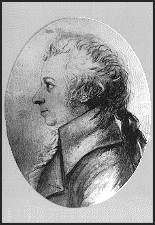
Growing debts
End of 1787 the Mozarts move downtown (Tuchlauben 27), a half year later
to the suburb again (Währinger Strasse 26 - both houses do not exist
anymore today). At Währinger Strasse Mozart composes his final
symphonies: E flat major (K543), G minor (K550) and C major (K551).
Mozart's performances are becoming rare. His financial situation is critical
all the time, he runs into debts again and again.
Journey to Berlin
After half a year, early 1789, he moves again, this time to the house
"Zur Mutter Gottes" at Judenplatz. Mozart travels to Berlin and stays
there from April to June. King Friedrich Wilhelm II of Prussia commissions
him with some minor compositions but he does not complete all of them.
At the house "Zur Mutter Gottes" he composes the clarinet quintet
(K581) and the opera "Così fan tutte" (K588) which has its
premiere on January 26, 1890 at the k.k. Nationaltheater.
Journey to Frankfurt
On February 20, 1790 Emperor Joseph II dies in Vienna. He is succeeded
by Leopold II who is to be crowned German Emperor in Frankfurt in October.
Mozart travels to the coronation celebrations in company of his brother-in-law.
He does, however, not have the artistic success he has hoped for and is
very disappointed.
Müller's Waxwork
Count Deym-Müller opens up a sort of waxwork exhibiting figures in
wax at Himmelpfortgasse. Visitors may also listen to music pieces performed
by automatic machines. Deym-Müller commissions several composers with
pieces for his music machines. Mozart composes three significant pieces
in total (K594, K608, K616) which may be listened to at hourly intervals
at Müller's Waxwork.
The final home
While Mozart stays in Frankfurt, his wife moves to Rauhensteingasse. Here
Mozart composes such significant works as the clarinet concerto
(K622), the "Zauberflöte" (K620) and the unfinished "Requiem"
(K626).
Mozart in Baden near Vienna
Constanze Mozart undergoes a longer spa treatment in Baden near Vienna.
She lodges with Anton Stoll, the choir-master of the Baden parish church
(Renngasse 4) for whom Mozart composes the famous "Ave verum" (K618).
"Die Zauberflöte" (The Magic Flute)
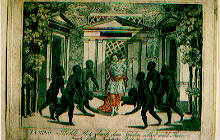
In 1789 Emanuel Schikaneder takes over the direction of the "Theater
auf der Wieden" at the "Freihaus" (Wiedner Hauptstrasse 10/Margaretenstrasse
10-16). In order to get rid of the theater's financial troubles, he commissions
Mozart with an opera, the libretto comes from Schikaneder himself. Mozart
starts with his composition in May 1791, on September 30 "Die Zauberflöte"
(K620) has its premiere with enormous success.
The "Requiem"
Mozart's legendary last composition is commissioned by a rich music devotee
who liked to conduct himself and whose intentions were to perform the "Requiem"
as his own opus in honor of his late wife. Mozart accepted the commission
in July 1791 from a mysterious messenger sent by the anonymous commissioner.
He did not know that he was working for Count Franz Walsegg-Stuppach who
in fact copied the "Requiem" in his own handwriting after Mozart's death
testifying with his signature that the composition was his own. Mozart
worked on this commission until he died.
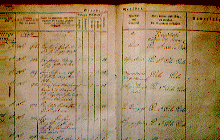 
|